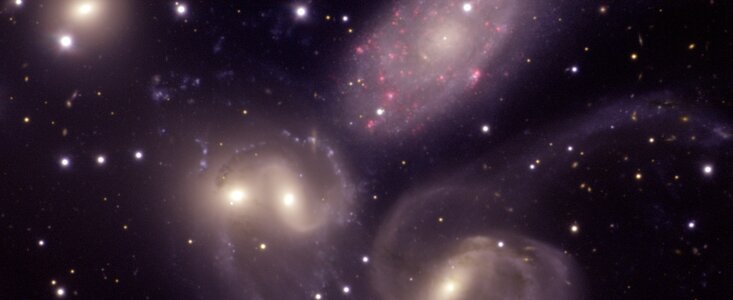Galactic Contortionists Captured by Gemini
9 October 2004
A stunning image released today by the Gemini Observatory captures the graceful interactions of a galactic ballet, on a stage some 300 million light years away, that might better be described as a contortionist's dance.
The galaxies, members of a famous troupe called Stephan's Quintet, are literally tearing each other apart. Their shapes are warped by gravitational interactions occurring over millions of years. Sweeping arches of gas and dust trace the interactions and possible ghost-like passage of the galaxies through one another. The ongoing dance deformed their structures while spawning a prolific fireworks display of star formation fueled by clouds of hydrogen gas that were shocked into clumps to form stellar nurseries.
This unprecedented image of the cluster provides a unique combination of sensitivity, high resolution and field of view. "It doesn't take long to reach an incredible depth when you have an 8-meter mirror collecting light under excellent conditions," said Travis Rector of the University of Alaska, Anchorage who helped obtain the data with the Gemini North Telescope on Mauna Kea. "We were able to capture these galaxies at many different wavelengths or colors. This allowed us to bring out some remarkable details in the final color image that have never been seen before in one view."
One striking element of the image is a collection of vibrant red clumps that mark star-forming regions within a galaxy called NGC 7320. Although its relation to the other galaxies in the cluster has been the subject of some controversy, most astronomers now think that the galaxy leads a relatively tranquil existence in the foreground, safely isolated from the violent quarrels of the more distant cluster.
Spectroscopic data show that NGC 7320 has an apparent velocity away from us of about 800 kilometers per second. In contrast, the rest of the group is being carried away from us by the expansion of the universe at over 6,000 kilometers per second. Using current models for the expanding universe, this would put the bulk of the cluster almost 8 times farther away from us than NGC 7320.
The vivid red patches scattered across the spiral arms of NGC 7320 in the new Gemini image provide a dramatic illustration of how these differing apparent velocities can impact our view. NGC 7320 and the other cluster galaxies have regions of intense star formation indicated by glowing clouds of hydrogen gas called HII regions. These areas appear distinctly red because a selective filter was used which only passes a special color of red light, called hydrogen alpha, that is produced in the HII regions. In the higher-velocity members of the cluster, prominent HII clumps dominate around the two closely interacting central galaxies but they do not appear red in the image. In these galaxies, the HII glow was Doppler-shifted beyond the range of the selective filter, and was therefore not detected.
The interacting members of Stephan's Quintet appear destined to continue their dance for millions more years. Eventually, this dance will probably cause some of the galaxies in the cluster to completely lose their current identity, combining into even fewer objects than we see today.
Stephan's Quintet was discovered in 1877 by the French astronomer Edouard Stephan using the Foucault 80-centimeter reflector at the Marseilles Observatory. The cluster is listed in the Hickson Compact Group Catalog as number 92. It has been studied extensively at all wavelengths including imaging by the Hubble Space Telescope. Recent observations of star cluster formation near Stephan's Quintet with Gemini can be found here.
| Filter | Wavelength Range | Assigned Color | Exposure | Seeing-FWHM |
| g' | 398-552 nm | Blue | 3x120sec | 0.72 |
| r' | 706-850 nm | Green | 3x120sec | 0.69 |
| i' | 562-698 nm | Yellow | 3x120sec | 0.6 |
| H-alpha | 654.2-661.1 nm | Red | 3x300sec | 0.65 |


